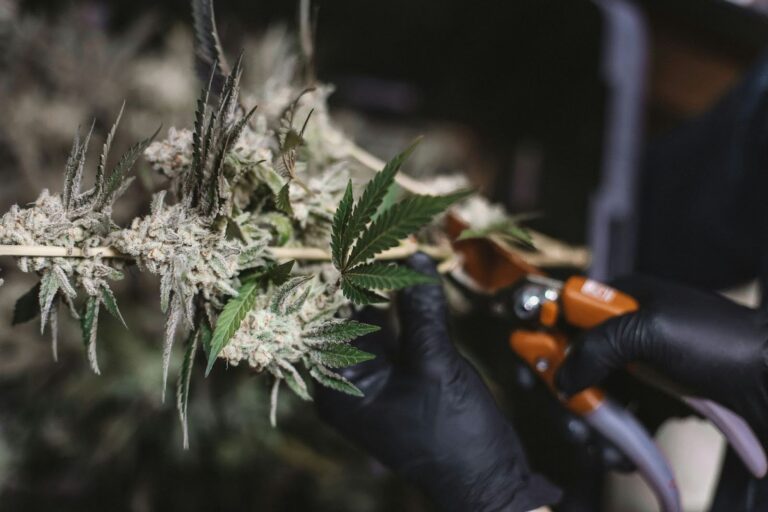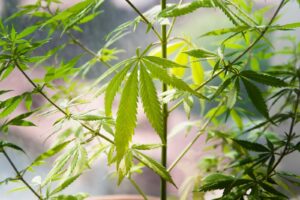Do you have white fuzz on your buds? As a grower, you’ve dialed in your lighting, kept humidity under control, and given your plants every ounce of care. You’ve put in the work to get dense, sticky buds that smell like heaven. But when you’re checking your plants before harvest, you spot something that stops you cold. There’s a weird dampness, a soft spot where it should be firm, and worst of all, a thin white fuzz starting to take hold.
That’s not just frustrating. It could mean serious trouble. What you’re looking at might not be extra trichomes or dust from the grow room. It could be white mold on weed, and it has the power to ruin entire harvests and even pose health risks to anyone using the product.
Mold can develop in any grow setup, whether you’re working with a simple home tent or a full-scale greenhouse. And once it appears, it doesn’t wait around. It spreads quickly and quietly, often before you notice something wrong.
In this guide, you’ll learn how to spot white mold early, understand how and why it spreads, and see how it differs from similar issues like powdery mildew or trichomes. More importantly, you’ll find out how to stop it, manage it, and keep it from returning. If you grow cannabis, this is something you can’t afford to ignore.
Understanding White Mold
White mold is a major threat to cannabis crops, and every grower needs to know what they’re dealing with. The culprit is a plant pathogen called Sclerotinia sclerotiorum, a fungus notorious for silently wiping out plants.
Here’s what makes it especially dangerous:
- Highly aggressive: Once white mold infects a plant, it spreads rapidly. It thrives in both outdoor gardens and tightly packed indoor grows where air circulation is weak, creating the perfect storm for an outbreak.
- Monocyclic infection cycle: White mold only needs one chance to infect your plant each season. After that, the damage is done. It doesn’t come in waves like some other pathogens. If you don’t catch it early, the plant is likely a goner.
- Hard to detect early: The infection often begins deep inside the bud or lower parts of the stem. When white fuzz appears on the surface, the internal damage is already severe.
- Produces long-lasting sclerotia: These hard, black structures allow the fungus to survive in dead plant material or soil for years. Even after harvest, the risk remains if you don’t clean thoroughly.
- Releases airborne spores: When disturbed, white mold can release spores into the air that land on nearby plants or surfaces, quickly starting new infections in your grow space.
Sclerotinia sclerotiorum produces hard, black resting structures called sclerotia that can survive in soil or plant debris for years. If you don’t fully clean and sanitize your grow area after an outbreak, it can become a long-term problem.
Understanding how this mold operates is the first step toward stopping it from spreading through your grow. Next up, let’s break down the exact conditions that help it take hold so you can avoid giving it a foothold in the first place.
Conditions That Let White Mold Thrive
White mold doesn’t show up by chance. It thrives when the growing environment gives it an opening. As a cannabis grower, here are the conditions that set the stage for a mold outbreak:
- Cool and moist environments: These are the perfect breeding grounds for white mold. If your grow area consistently stays cool and damp, you’ve created ideal conditions for spores germinating. This is especially risky when temperatures dip and condensation builds in the early morning or nighttime hours.
- High humidity: Levels above 60 percent, especially without adequate air circulation, make it easy for white mold to take root. Dense canopies that trap moisture only make things worse. Humidity spikes during dark cycles or after irrigation also increase the risk.
- Poor airflow: Stagnant air around buds creates microclimates of trapped humidity. Without proper ventilation, these pockets become mold hotspots. Oscillating fans and well-planned exhaust systems are essential to keeping air moving through the canopy.
- Wet leaves and condensation: Water left on leaves after foliar spraying or watering can increase the risk. Mold often starts in spots where moisture lingers too long. Use low-pressure sprays and always water at the base when possible.
- Improper post-harvest storage: Even after a successful harvest, mold can sneak in. If buds are jarred while still moist or stored in airtight containers with residual humidity, you’re inviting mold to grow from the inside out. Always monitor RH levels in jars using hygrometers.
- Unclean grow space: Mold spores can survive on tools, plant debris, pots, and floors. A grow room that’s not routinely sanitized becomes a ticking time bomb. Use hydrogen peroxide or alcohol to clean surfaces and remove organic waste after every cycle.
Monitoring and adjusting these environmental factors consistently throughout the grow cycle and into curing and storage is key to keeping your crop mold-free. With PlanaCan, you can generate detailed harvest reports that track your cultivation decisions and their impact on yield.
All your data stays in one place, making it easier to spot trends over time. By reviewing these reports, you can see what works, avoid past mistakes, and refine your process for better yields and profitability while also maintaining the conditions needed to prevent mold.
Now, let us understand how to differentiate white mold from other issues that affect cannabis plants.
How to Identify White Mold and Differentiate It from Similar Issues
Not everything white and fuzzy is white mold, and as a grower, you need to know what you’re dealing with before taking action. Several other issues can mimic its appearance, and making the wrong call could cost you healthy plants.
- Powdery mildew: This is one of the most common lookalikes. It usually appears as a fine white or gray coating on the leaves rather than inside the buds. Unlike white mold, it tends to stay on the surface and doesn’t rot plant tissue from the inside.
- Trichomes: These are your plant’s natural resin glands. They’re supposed to be there and are a good sign of potency. Under light, they shimmer like crystals. In contrast, white mold looks matte and dusty and may resemble spiderwebs or dull fuzz.
- Nutrient or pest issues: Sometimes, pest webs or certain deficiencies can look moldy at a glance. A close inspection with a magnifying glass or jeweler’s loupe can help you spot whether you’re seeing living mold or something else entirely.
To help you quickly compare, here’s a simple breakdown of the key differences:
Feature | White Mold | Powdery Mildew | Trichomes |
Location | Inside buds and stems | Leaf surfaces | All over buds and sugar leaves |
Texture | Cottony, fuzzy, or dusty | Powdery and dry | Oily, crystal-like |
Color | Dull white to gray | White to light gray | Shiny white or amber |
Damage | Rots tissue from inside | Surface-level only | No damage, part of healthy plant |
Smell | Musty, rotten | Slight mildew scent | Strong, pungent cannabis aroma |
Removal | Discard infected parts | Can sometimes treat | Not needed |
Now, let us understand the signs of white mold on your cannabis plant.
Signs of White Mold on Cannabis
White mold has a distinct look but is surprisingly easy to miss, especially in the early stages. As a cannabis grower, spotting it early can be the difference between saving your crop and losing it. Here’s what you need to watch for:
- Cotton-like fuzz on buds: This is the most obvious visual cue. The mold looks like soft, white fluff or cobwebs tangled in your buds. If you spot this, do not ignore it. This is white mold setting in.
- Water-soaked lesions: Check your stems and buds closely. Water-soaked spots are an early warning. They often appear mushy and wet and may become darker or collapse if left untreated.
- Stem bleaching: Infected stems may lose their color and look pale, grayish, or ghostly white. This happens as the mold damages the inner tissue and cuts off nutrient flow.
- White fuzz and bud discoloration: The initial mold growth might seem harmless, but it spreads fast. Over time, buds may rot from the inside. If your buds start turning brown, gray, or dusty white and aren’t trichomes, it’s likely mold.
- Dusty or powdery surface: Sometimes, mold doesn’t look fluffy. It may resemble a thin, even layer of white powder, especially on sugar leaves or smaller buds. If you see this and it doesn’t sparkle like trichomes under light, take it seriously.
- Weak or hollow stems: White mold can eat away at the structural integrity of your plant. If you notice stems snapping easily or feeling hollow, it could be a sign that mold is working from the inside out.
- Off smell: Healthy cannabis has a distinct aroma, but moldy buds often smell musty, damp, or even sour. If your nose picks up something that seems off, trust it. Mold has a way of letting its presence be known through smell before it’s fully visible.
- Sticky but not in a good way: While resinous buds are naturally sticky, moldy buds can feel damp or greasy instead. That slick texture should raise alarms, especially if combined with any other signs above.
Here is a table to help you better understand the signs of white mold.
Sign | Description |
Cotton-like fuzz on buds | White, cobweb-like mold in buds is a clear sign of infection. |
Water-soaked lesions | Mushy, wet spots on stems or buds may darken or collapse. |
Stem bleaching | Stems look pale or gray as mold blocks nutrients. |
Bud discoloration | Buds turn brown, gray, or dusty white. No trichome sparkle. |
Dusty or powdery surface | Thin white powder on leaves or buds that lacks trichome shine. |
Weak or hollow stems | Stems feel soft, snap easily, or seem hollow. |
Off smell | Musty, sour smell unlike normal cannabis aroma. |
Sticky but not resinous | Buds feel greasy or damp, not sticky. |
Now, let’s understand how to handle, manage, and prevent white mold in your cannabis plant and ensure healthy growth.
Handling, Management, and Prevention of White Mold in Cannabis
Whether you’re growing indoors or outdoors, staying proactive and consistent is the best way to protect your plants. Here’s how you can handle, manage, and prevent white mold effectively.
- Identify and Inspect Regularly: Check your plants every day. Look for early signs like white, cotton-like fuzz on buds, stems, or leaves. If buds feel soft or begin turning brown from the inside, take action quickly. Early detection gives you a much better chance of saving your crop.
- Control Humidity and Temperature: Keep humidity between 40 and 50 percent, especially during flowering. White mold thrives in damp, cool air. Use a dehumidifier if needed and maintain a steady temperature to make conditions less comfortable for mold.
- Ensure Good Air Circulation: Use fans to create steady airflow around your plants. Avoid overcrowding and prune dense areas to prevent stale pockets of air where mold can grow.
- Prune, Clean, and Sanitize: Trim away dead or unnecessary plant material. Clean up fallen leaves and debris. Sanitize your tools and surfaces often to stop spores from spreading.
- Water Wisely: Do not overwater. Let the top layer of your soil dry before watering again. Make sure your growing medium drains well. If growing outdoors, water early in the day so plants can dry before nightfall.
- Quarantine New Plants: Before adding any new plants to your grow area, isolate them for a few days. Watch closely for signs of mold or pests. This helps protect your existing plants from sudden contamination.
- Use Preventative Sprays: Apply natural antifungal treatments like neem oil or potassium bicarbonate. Always test on a small area first to make sure your plants tolerate it. These sprays can help reduce the risk of mold taking hold.
- Remove and Dispose of Infected Areas: If you find white mold, remove the affected parts immediately. Do it carefully to avoid spreading spores. Clean your tools after use. Never compost infected material. Bag it and throw it away, far from your plants.
- Stay Consistent: Consistency is the most important part of managing white mold. Check your plants daily, maintain the right environment, and respond quickly to any problems.
Conclusion
White mold on cannabis is not just a grower’s problem. It affects everyone who uses the product. Moldy cannabis is more than just unpleasant. It poses real health risks. You protect your health and crop quality by staying alert, spotting the early signs, and managing your growing and storage conditions carefully.
You do not have to manage everything manually. PlanaCan provides easy-to-use tools to help you maximize yields and stay in control of your cultivation process.
With PlanaCan, you can take full control of your grow using tools designed to help you maximize yields and stay organized. It lets you create custom templates for each strain or harvest cycle, outlining every step from planting to harvest. Once your templates are ready, you can schedule tasks onto a calendar with just a few clicks, keeping your workflow consistent and stress-free.
It also gives you a clear visual timeline to plan months ahead and manage daily activities. You can easily adjust tasks as needed and make sure nothing gets missed. With all your cultivation tasks in one place, you and your team always know what needs to be done and when.
Stay ahead of white mold and other common problems with better planning and organization.
Schedule a free call today to see how PlanaCan can help you grow smarter.




